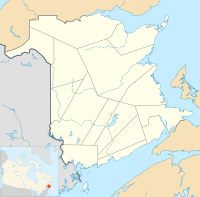Burnt Church First Nation facts for kids
Quick facts for kids
Esgenoôpetitj (Burnt Church)
|
|
|---|---|
| Country | Canada |
| Province | New Brunswick |
| County | Northumberland County |
| Established | 1802 |
| Area | |
| • Total | 44.055 km2 (17.010 sq mi) |
| Lowest elevation | 0 m (0 ft) |
| Population
(2011)
|
|
| • Total | 1,715 |
| Time zone | UTC-4 (Atlantic (AST)) |
| • Summer (DST) | UTC-3 (ADT) |
| NTS Map | 21P3 Chatham |
| Postal code span: | |
Eskɨnuopitijk or Esgenoôpetitj is a Mi'kmaq First Nation community in New Brunswick, Canada. It is also known as the Burnt Church First Nation. The community is located near Lagacéville and Neguac on Miramichi Bay.
The First Nation manages two Indian reserves in Northumberland County. These are Esgenoôpetitj 14 and Tabusintac 9. They also manage two reserves in Gloucester County: Pokemouche 13 and Pabineau. In 2011, about 1,715 people lived there. The Mi'kmaq name Esgenoôpetitj means "a lookout".
Contents
Exploring the History of Esgenoôpetitj
How Did Burnt Church Get Its Name?
The land where Esgenoôpetitj is located has been home to First Nations people for a very long time. Maps from as early as 1727 show that people lived here.
The name "Burnt Church" comes from an event in 1758. During a conflict, British General James Wolfe sent Colonel James Murray to destroy French settlements in the Miramichi area. As part of this, a stone church was burned down. This is how the area got its current name.
When Was the Reserve Established?
Burnt Church was one of the first Indian reserves created in New Brunswick. It was officially set aside on March 5, 1805. The reserve covered about 2,058 acres (8.33 square kilometers). At that time, it was a very important and large Mi'kmaq settlement in New Brunswick.
Who Else Settled in the Area?
After the Seven Years' War, some Acadian families returned to live near the reserve. Later, many new settlers from Scotland also moved to the area. Because of this, the name "Burnt Church" now refers to both the First Nation community and the nearby non-native community.
Understanding Fishing Rights Disputes
In recent years, members of the Burnt Church First Nation have worked hard to protect their traditional lobster fishing rights. This led to a period of disagreement known as the Burnt Church Crisis. This involved discussions with the provincial and federal governments, as well as local non-native fishermen. The community worked to ensure their rights to fish were recognized and respected.
Images for kids
-
A painting from 1758 showing the Raid on Miramichi Bay and Burnt Church Village.




